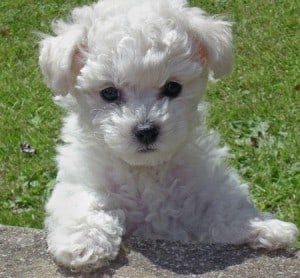From the desk of Sharda Baker.
Thursday, February 06, 2014
Hi and welcome everyone!
This is Sharda Baker with your first Bichon Frise newsletter!
The Bichon Frise is really an interesting and beautiful dog.
I think you’ll be interested to know the History Of The Bichon Frise Dog humble beginnings of this funny and fluffy breed which is why today we will do a little background check about the Bichon Frise and learn about this dog’s history before anything else.
So, let’s start shall we?
The Bichon Frise has been a favorite of royalty as well as of typical families since the beginning of the fourteenth century.
These dogs have been immortalized in paintings by artists such as Goya and Titian, which help to confirm the popularity of this breed in several different countries and in different periods of time.
There are many different stories or ideas about the actual origins of the breed.
Most breeders agree that the dog was first developed by crossing a small sized Poodle with the Barbet Water Spaniel.
There are also breeders that believe that the Bichon Frise was developed from the Maltese breed crossed with other popular mixed breed lapdogs of the time, most likely predominantly including the Poodle and Barbet Spaniel type breeds.
The Barbet Water Spaniel, more commonly known as the Barbet, is very similar in temperament and characteristics to the Standard Poodle and has been used in the development of many of the European breeds of spaniels and companion dogs.
The Poodle also can trace its history back to early hunting dogs; however, it is more commonly known today as a companion dog.
The cross of the two breeds seems to have incorporated the most positive aspects of both into the Bichon Frise.
The original name of the Bichon Frise was the Barbichon, which was then shorted to the now common “Bichon”.
In the early history of the Bichon Frise, the dogs were used a trading commodity throughout their native land of Spain and in the Mediterranean areas.Sailors would take these small, lively, and intelligent dogs with them on their voyages, using the dogs to trade for other items on their travels.
In this way, the breed was spread along shipping routes and was considered to be a sign of distinction and wealth as only affluent traders were able to secure one of these powder-puff looking dogs.
As the dogs increased in popularity, more of the ladies and gentlemen of the various courts demanded smaller and smaller Bichon Frise dogs, leading breeders to strive for the size of Bichon Frise that is now common, rather than the larger original versions of the breed.
The Bichon Frise dogs of royalty were pampered well; typically, they were groomed, perfumed, and carried almost everywhere, eating from their owner’s fingers or from specially prepared foods.
The dogs, however, due to their high level of intelligence and amazing ability to learn complex routines were very much sought after by circuses, traveling performers and other entertainers.
For many years, the Bichon Frise was popular as a circus dog and was used in carnivals and circuses all over Europe. In addition, the small little dog was very popular in France as a companion and house dog.
In 1933, just after the First World War, a group of Bichon Frise breeders in France met to determine a breed standard that would be used universally across the four lines of the Bichon Frise.
The resulting standards were adopted by the Societe Centrale Canine of France and the combined name of Bichon Frise was adopted as the official breed name.
In 1934, the breed was further recognized by the French Kennel Club.
The first Bichon Frise was brought to the United States in 1956 and the American Kennel Club officially recognized it as a breed in 1971 in the Miscellaneous Class.
The following year, they were allowed into the AKC stud book and on April 4th 1973 the breed officially was recognized in the Non-sporting group of the AKC. Currently, the Bichon Frise is considered to be one of the top fifty most popular dogs in the United States and holds similar distinctions in most other countries and areas of the world.
The American Kennel Club ranks the Bichon Frise as the 26th most registered breed through their registry as of 2005.
The amazing versatility of the Bichon Frise, as well as its gentle and fun loving personality, continue to make it a popular dog for many different types of events as well as being a wonderful companion.
Breeders strive today, as they have for centuries, to retain the intelligence and gentleness of the breed while improving on the lines through selective and careful breeding programs.
Truly the history of these intelligent and versatile breed is a colorful one!
I hope that you enjoyed today’s Bichon Frise newsletter.
All the best and take care
Warmly,
Sharda Baker

